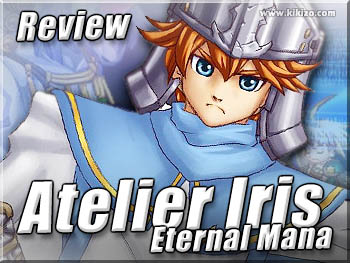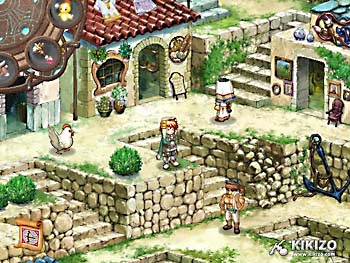Atelier Iris: Eternal Mana
The little-known yet charming RPG snuck onto store shelves about a month ago, and it's already a rare title. Should fans take the time to track it down?
| Version PS2 | Developer Gust | Publisher Nippon Ichi | Genre RPG |
||||
By Ben S. Dutka
The PS2 is the platform to find niche role-playing games, titles that appeal to only a select few of the most hardcore RPG fans. The Atlus trilogy of strategy/RPGs (Disgaea: Hour of Darkness, La Pucelle Tactics, Phantom Brave) fall into this category, and despite garnering some high critical acclaim; remain mostly unpopular. Disgaea may be considered a cult classic and possibly the best SRPG of this generation, but that's as far as it goes.

Atelier Iris: Eternal Mana is another such title, developed with a specific fanbase in mind, a tiny or even non-existent advertising campaign, and a whole lot of Japanese style. Gust and NIS America have teamed up to finally bring an Atelier title to the U.S., and those familiar with the series should've been salivating. The question is, was it worth the trouble?
The graphical style of the game is quite unique, as the designers put a heavy emphasis on diverse coloration and vivid scenery. Each town, forest, and dungeon looks as if they were cut straight from a coloring book. The environments feature broad strokes of a painter with a particular affinity for the bursting brightness of reds, yellows, blues, and greens. The first town, Kavoc, is more reminiscent of Hansel and Gretel rather than Final Fantasy.
The character design is quite good, with a nice bit of detail and variety throughout your party members and the world's inhabitants. A great deal of effort was placed into every nook and cranny; a large part of the environment could pass for hand-drawn artistry. In this way, RPG buffs who may have played Legend of Mana for the PSOne might recognize the style, to a point. In short, the cartoon-ish graphics may turn off some people, and don't exactly represent the finest technical achievement of this generation, but they're more than passable. In fact, they're perfectly suited to the game's style.
Both the soundtrack and sound effects are a breath of fresh air, as some nicely orchestrated tracks follow you on your adventures. The voice-over dialogue is done very well, with several talented people lending their voices to the main characters. There is an option to skip dialogue, but much of the discussion is quite entertaining. There is a great deal of comical relief in the game, and thankfully, it's not over the top or exceedingly corny. There could've been more variety to the tracks, but most of the theme music - especially for the final battle - is produced extraordinarily well. The only downside is the numerous technical glitches; dialogue and sound effects will stick at certain points, knocking the overall performance of this category down a notch or two.
The gameplay revolves around the highly unique Alchemy system, which acts as the very foundation of the game. Klein is the main character, and an Alchemist. He combines elemental forces into spells with the help of Mana, friendly little creatures that have a tremendous effect on the game. Each Mana represents an element; Wood, Water, Air, Fire, Stone, Light, Holy, Evil, Lightning, Power, Time, etc, and they are used to combine elements into spells for Klein. For example, you will use 2 Water elements to create a Heal Bulb. The higher-level spells require more elements, and combinations of elements.
These elements are acquired by Klein's special cane. He can "absorb" enemies in battle - a ghost might give you 6 Spirit elements, for example - and he can also absorb many things around him. He can use his cane on a bush for Wood and Water elements, a rock for Stone elements, and a gargoyle statue for Holy elements. You can hold up to 99 of each element, and as you find new spells to create, you will use up these elements for the spells. Klein can have up to 9 of each spell in his arsenal, and can even Synthesize spells while in battle.
A Mana is used to help with the Synthesis of these spells; you'll need Uru, the Fire Mana to mix Fire elements, and some other Mana can help synthesize more than one element. These Mana work hard, so they need to be kept happy. You can supply them with gifts along the way to keep their morale high, and keep them effective. Some Manas even give you an extra exploring ability. For example, the Stone Mana can be summoned to form a slab of stone, used as a step to reach higher places. The Light Mana can be summoned to ward of enemies so as to avoid random encounters.
Synthesis doesn't end with spells, either. There are tons of items to be found and created, many of which are actually food items. You will encounter many shops in your adventure, and most of them will allow you to purchase a wide variety of items, and also Synthesize new ones. You will use raw materials you collect in the environment to create these new items, and several are essential for opening up some of the hidden side-quests. This side of the game will appeal only to micromanagement fans; collection and completion freaks who have that driving need for 100%.
Combat is centered on a random-encounter, turn-based battle system, very reminiscent of the 16-bit era RPGs. Your party of three is on the right while the enemy group is on the left; you can have up to six party members, and like FF X, you can switch them in and out during battle. The difficulty with this setup is that smaller enemies are frequently hidden behind bigger enemies, and unless you take the time to scroll through your foes, you won't even know they're on the field until they attack. It sounds like a small complaint, but it happened enough times where it became quite annoying.
The difficulty starts off very low, and suddenly, after about 15 hours of gameplay, the challenge takes a steep turn upwards. Even the most accomplished veteran players will be surprised at one particular boss battle, and the difficulty stays high from there on in. The final battle will leave some people shaking their heads, wondering why they're being annihilated, and why their high level isn't helping them. And this leads me to the final issue regarding the gameplay: your ultimate success doesn't depend entirely on gaining levels, but more on how you approach character use and weapon synthesis.
You can fuse two Mana Stones together to create a special Mana Crystal, which can then be affixed to certain weapons and accessories. Unfortunately, while this process sounds intriguing, most equipment can't be used, and only through experimentation will you persevere. However, if you get the hang of it, you can instantly transform a character into a deadly powerhouse. In the end, the gameplay revolves around real-time Zelda-like exploration, and hinges on how you approach the combat and its surrounding facets.
While it may sound incredibly deep, the combat itself is actually very straightforward. Unfortunately, the skill tables available to each character only have 8-10 abilities, half of which are eclipsed early by the latter half. These skills level up right along with you (Manas help as well; they can add bonus points to certain skills when equipped), but you'll find yourself using the same skills against the toughest enemies, again and again. This undercuts the overall depth a great deal, because without taking advantage of weapon synthesis, battle just becomes very tedious and repetitive. And lastly, there simply isn't a more linear RPG currently on the shelves; your path is opened up, step by step. Therefore, exploration of the world map is essentially non-existent.
It's all about style, with Atelier Iris. Either you love it or hate it; there's no better explanation. The presentation is top-heavy with humorous and engaging character dialogue, quaint and picturesque towns, and nicely rendered dungeons and forests. The "cartoonish" look and feel of the game is well produced, and the only real drawback lies in the technical problems. Besides skipping of voices, the game also has the tendency to freeze as you approach the end. But if you can deal with a little inconvenience, and you find yourself smiling at the very first town, you're guaranteed to enjoy the rest.
Atelier Iris: Eternal Mana, taken purely on its merits alone, is not a top-notch RPG. The depth is there, but much of it is not required. If the player is willing, there's more than enough extra stuff to keep them occupied well beyond the 30-35 hour adventure. But the story is completely generic and terribly written; most will lose interest immediately. The main focus of the game is on the gameplay, but with an RPG of this nature, it needed a coherent and somewhat engaging plotline.
The huge swing in difficulty about halfway through will annoy some people, and others may be immediately turned off by the complete linearity and uninspired battle format. But for RPG aficionados, it turns out to be an amusing romp. They will appreciate the depth, even though it's not forced upon them, they will appreciate the effort put in to the character dialogue, and they will revel in the gameplay that doesn't rely entirely on gaining levels. Atelier Iris certainly has a lot going for it, but it simply can't compete with some of the heavier hitters currently in the RPG genre.
| ||||||||||||
|



























 Satoru Iwata Video Interview - the late Nintendo president spoke with Kikizo in 2004 as 'Nintendo Revolution' loomed.
Satoru Iwata Video Interview - the late Nintendo president spoke with Kikizo in 2004 as 'Nintendo Revolution' loomed. Kaz Hirai Video Interview - the first of Kikizo's interviews with the man who went on to become global head of Sony.
Kaz Hirai Video Interview - the first of Kikizo's interviews with the man who went on to become global head of Sony. Ed Fries Video Interview - one of Xbox's founders discusses an epic journey from Excel to Xbox.
Ed Fries Video Interview - one of Xbox's founders discusses an epic journey from Excel to Xbox. Yu Suzuki, the Kikizo Interview - we spend time with one of gaming's most revered creators.
Yu Suzuki, the Kikizo Interview - we spend time with one of gaming's most revered creators. Tetris - The Making of an Icon: Alexey Pajitnov and Henk Rogers reveal the fascinating story behind Tetris
Tetris - The Making of an Icon: Alexey Pajitnov and Henk Rogers reveal the fascinating story behind Tetris Rare founders, Chris and Tim Stamper - their only interview? Genuinely 'rare' sit down with founders of the legendary studio.
Rare founders, Chris and Tim Stamper - their only interview? Genuinely 'rare' sit down with founders of the legendary studio. The History of First-Person Shooters - a retrospective, from Maze War to Modern Warfare
The History of First-Person Shooters - a retrospective, from Maze War to Modern Warfare